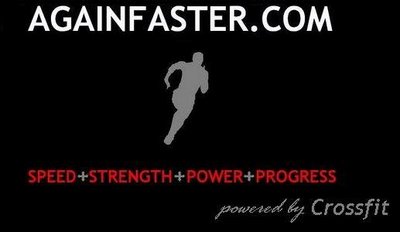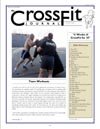The Tactical Strength Challenge

Again Faster and Crossfit Boston are hosting a venue for the 2007 Tactical Strength Challenge. The competition begins at 10:00 a.m. on Saturday, March 3rd, immediately following the 9:45 a.m. weigh-in.
The TSC tests absolute strength, strength-to-bodyweight, and strength endurance using three events: the deadlift, deadhang pull-ups, and the kettlebell snatch. The competition will be refereed by myself and RKC Lynne Pitts of Crossfit fame.
The rules are as follows, posted directly from the Tactical Strength Challenge Website. They're not complicated, but we will be following them to the letter, and we expect all competitors to arrive with a basic knowledge of the event layout.
To register for the Tactical Strength Challenge, please complete a waiver and bring it with you on the day of the competition. Day-of-competition entries are at the referees' discretion.
The Rules:
Contest: The contest must be held on a single day. The events consist of a three-attempt powerlifting deadlift, pullups for max reps, and kettlebell snatches for max reps in a 5:00 time period. There are three competition classes: Men's Division, Men's Elite Division, and Women's Division. There may be separate awards for Masters (competitors over 50, same as the RKC, not the more common over 40) at the organizers' discretion; however, Masters lifters should lift in the same flights as other competitors. The weights used for pullups and snatches vary by competition class as described below.
The events must be contested in the order of deadlift, pullups, snatches. Each competitor must be allowed at least 15 minutes of rest between events but 30-60 minutes is recommended.
Scoring: In the deadlift, the winner is the competitor that successfully lifts the most weight. In the pullups and snatches, the winner is the competitor that successfully performs the most repetitions. The winner is determined by combined placement in the three events. For example:
If Lifter A finishes third in the deadlift, fifth in pullups, and second in snatches, his score is 10 (3+5+2).
If Lifter B finishes first in the deadlift; third in pullups, and third in snatches, his score is 7 (1+3+3).
The lowest combined score wins. In the above example, Lifter B would finish higher than Lifter A (7 is lower score than 10).
In the event of a deadlift tie, the lighter competitor places higher. In the event of a pullup tie, the heavier competitor places higher. In the event of a snatch tie, the tie stands. In the event of an overall tie (two or more lifters get same combined score), the tie stands.
Equipment: The equipment consists of a standard Olympic bar and plates, a 16kg, 24kg, or 32kg kettlebell, a pullup bar, a weight belt with a chain, and a timer. The pullup bar should be high enough so that tall competitors can use it without excessively bending their legs. It should also be sturdy enough to handle heavier competitors and kettlebells.
The weight belt with a chain is for weighted pullups in the Men's Elite Division. Competitors may use their own weightlifting or powerlifting belts for the deadlift event, but not for other events.
Deadlift: For the deadlift, the bar will be loaded to the weight the competitor specifies and placed on the ground. The competitor will approach the bar and lift it in one continuous motion. When the weight is fully locked out (knees and back fully straightened), the referee will give the "Down" command and the competitor will drop the bar or lower it under control.
The competitor has three attempts and may specify the same weight or a heavier weight in each successive attempt. The competitor may not request a lighter weight after missing with a heavier weight.
Pullups: In the Men's/Masters division and the Women's Division, bodyweight pullups are performed. A chinup grip, with the palms facing the lifter, is not allowed; the palms must face away. The grip may be thumbless or not, but most competitors find they do best with a thumbless grip.

In the Men's Elite division, pullups are performed with 22 lbs (10kg) attached to the competitor using a weight belt and chain. The total assembly (weight belt and plates) should weigh between 21 and 23 lbs and should be weighed before the competition. Any assembly of belt and plates in this weight range is official and will count for competition purposes or for TSC records.
For pullups, the competitor will approach the bar, grasp it with both hands, and settle into a dead hang with both arms fully straightened. (Competitors may initially stand on a block or box in order to reach the bar.) After settling into a dead hang, the competitor will pull with both arms, using no kipping or swinging, and pull up until the neck or the chest cleanly touches the bar. The competitor will then lower back to a dead hang and do another rep.
For each successful rep, the referee will count 1, 2, 3, and so on. The set is terminated when the competitor quits or fails to make three successive attempts.
Kettlebell snatches: In the Men's/Masters division, a 24kg kettlebell is used. In the Men's Elite division, a 32kg kettlebell is used. In the Women's Division, a 16kg kettlebell is used. Competitors may use chalk to improve their grip.
A snatch is defined as swinging a single kettlebell between the legs with one arm, bringing the kettlebell overhead in a single motion, and locking it out overhead with a straight arm. After each rep, the competitor will let the kettlebell fall in a single motion (without dropping the kettlebell to the chest or shoulder) and perform another rep. The knees must be locked out at the completion of the lift for the rep to count. The competitor may not use the non-lifting arm to assist the lift in any way - the lift does not count if the free arm or some other part of body touches the platform, the kettlebell, the working arm, the legs, or the torso.
The competitor has 5:00 to perform as many repetitions as possible. The referee will use a timer and tell the competitor when to begin. Once the timer starts, the competitor can snatch with either arm and switch arms as many times as he/she prefers. The competitor can also set the kettlebell down on the ground, rest, or pace on or around the platform (without disturbing other competitors). The set is terminated when the competitor quits or the 5:00 time limit expires. If the competitor violates another technical rule during performance of the set (for example, lowers the kettlebell to the shoulder), the set is not terminated, but the rep preceding the violation does not count. The competitor may resume performing repetitions provided that he/she complies with all relevant rules.
Referee's discretion: The rules of the TSC are basic and straightforward. A brief rules meetings should precede each event but should be brief and not legalistic. The referee may, at his/her discretion, disallow any unorthodox equipment or practice that he/she feels provides a competitor with an unfair advantage. The exact equipment or practice does not have to be disallowed specifically by these rules.
Now that that's out of the way, we hope you can make it! Lynne promises not to beat you--too badly. Crossfit Boston is located at 123 Terrace St., Roxbury Crossing, MA. We'll start the lifting at 10:00 a.m. sharp!
Go faster!
All pictures courtesy of www.tacticalstrengthchallenge.com.

Again Faster and Crossfit Boston are hosting a venue for the 2007 Tactical Strength Challenge. The competition begins at 10:00 a.m. on Saturday, March 3rd, immediately following the 9:45 a.m. weigh-in.
The TSC tests absolute strength, strength-to-bodyweight, and strength endurance using three events: the deadlift, deadhang pull-ups, and the kettlebell snatch. The competition will be refereed by myself and RKC Lynne Pitts of Crossfit fame.
The rules are as follows, posted directly from the Tactical Strength Challenge Website. They're not complicated, but we will be following them to the letter, and we expect all competitors to arrive with a basic knowledge of the event layout.
To register for the Tactical Strength Challenge, please complete a waiver and bring it with you on the day of the competition. Day-of-competition entries are at the referees' discretion.
The Rules:
Contest: The contest must be held on a single day. The events consist of a three-attempt powerlifting deadlift, pullups for max reps, and kettlebell snatches for max reps in a 5:00 time period. There are three competition classes: Men's Division, Men's Elite Division, and Women's Division. There may be separate awards for Masters (competitors over 50, same as the RKC, not the more common over 40) at the organizers' discretion; however, Masters lifters should lift in the same flights as other competitors. The weights used for pullups and snatches vary by competition class as described below.
The events must be contested in the order of deadlift, pullups, snatches. Each competitor must be allowed at least 15 minutes of rest between events but 30-60 minutes is recommended.
Scoring: In the deadlift, the winner is the competitor that successfully lifts the most weight. In the pullups and snatches, the winner is the competitor that successfully performs the most repetitions. The winner is determined by combined placement in the three events. For example:
If Lifter A finishes third in the deadlift, fifth in pullups, and second in snatches, his score is 10 (3+5+2).
If Lifter B finishes first in the deadlift; third in pullups, and third in snatches, his score is 7 (1+3+3).
The lowest combined score wins. In the above example, Lifter B would finish higher than Lifter A (7 is lower score than 10).
In the event of a deadlift tie, the lighter competitor places higher. In the event of a pullup tie, the heavier competitor places higher. In the event of a snatch tie, the tie stands. In the event of an overall tie (two or more lifters get same combined score), the tie stands.
Equipment: The equipment consists of a standard Olympic bar and plates, a 16kg, 24kg, or 32kg kettlebell, a pullup bar, a weight belt with a chain, and a timer. The pullup bar should be high enough so that tall competitors can use it without excessively bending their legs. It should also be sturdy enough to handle heavier competitors and kettlebells.
The weight belt with a chain is for weighted pullups in the Men's Elite Division. Competitors may use their own weightlifting or powerlifting belts for the deadlift event, but not for other events.
Deadlift: For the deadlift, the bar will be loaded to the weight the competitor specifies and placed on the ground. The competitor will approach the bar and lift it in one continuous motion. When the weight is fully locked out (knees and back fully straightened), the referee will give the "Down" command and the competitor will drop the bar or lower it under control.
The competitor has three attempts and may specify the same weight or a heavier weight in each successive attempt. The competitor may not request a lighter weight after missing with a heavier weight.
Pullups: In the Men's/Masters division and the Women's Division, bodyweight pullups are performed. A chinup grip, with the palms facing the lifter, is not allowed; the palms must face away. The grip may be thumbless or not, but most competitors find they do best with a thumbless grip.

In the Men's Elite division, pullups are performed with 22 lbs (10kg) attached to the competitor using a weight belt and chain. The total assembly (weight belt and plates) should weigh between 21 and 23 lbs and should be weighed before the competition. Any assembly of belt and plates in this weight range is official and will count for competition purposes or for TSC records.
For pullups, the competitor will approach the bar, grasp it with both hands, and settle into a dead hang with both arms fully straightened. (Competitors may initially stand on a block or box in order to reach the bar.) After settling into a dead hang, the competitor will pull with both arms, using no kipping or swinging, and pull up until the neck or the chest cleanly touches the bar. The competitor will then lower back to a dead hang and do another rep.
For each successful rep, the referee will count 1, 2, 3, and so on. The set is terminated when the competitor quits or fails to make three successive attempts.
Kettlebell snatches: In the Men's/Masters division, a 24kg kettlebell is used. In the Men's Elite division, a 32kg kettlebell is used. In the Women's Division, a 16kg kettlebell is used. Competitors may use chalk to improve their grip.
A snatch is defined as swinging a single kettlebell between the legs with one arm, bringing the kettlebell overhead in a single motion, and locking it out overhead with a straight arm. After each rep, the competitor will let the kettlebell fall in a single motion (without dropping the kettlebell to the chest or shoulder) and perform another rep. The knees must be locked out at the completion of the lift for the rep to count. The competitor may not use the non-lifting arm to assist the lift in any way - the lift does not count if the free arm or some other part of body touches the platform, the kettlebell, the working arm, the legs, or the torso.
The competitor has 5:00 to perform as many repetitions as possible. The referee will use a timer and tell the competitor when to begin. Once the timer starts, the competitor can snatch with either arm and switch arms as many times as he/she prefers. The competitor can also set the kettlebell down on the ground, rest, or pace on or around the platform (without disturbing other competitors). The set is terminated when the competitor quits or the 5:00 time limit expires. If the competitor violates another technical rule during performance of the set (for example, lowers the kettlebell to the shoulder), the set is not terminated, but the rep preceding the violation does not count. The competitor may resume performing repetitions provided that he/she complies with all relevant rules.
Referee's discretion: The rules of the TSC are basic and straightforward. A brief rules meetings should precede each event but should be brief and not legalistic. The referee may, at his/her discretion, disallow any unorthodox equipment or practice that he/she feels provides a competitor with an unfair advantage. The exact equipment or practice does not have to be disallowed specifically by these rules.
Now that that's out of the way, we hope you can make it! Lynne promises not to beat you--too badly. Crossfit Boston is located at 123 Terrace St., Roxbury Crossing, MA. We'll start the lifting at 10:00 a.m. sharp!
Go faster!
All pictures courtesy of www.tacticalstrengthchallenge.com.




















0 Comments:
Post a Comment
<< Home